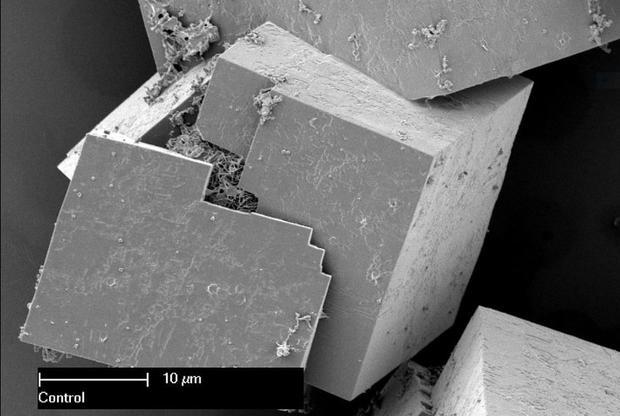Conventional means of removing radioactive gasses operate at extremely low, high energy temperatures. There are a number of systems for removing gaseous waste. Some are designed to retain the fission and activation gasses for radioactive decay to extremely low levels prior to release. Retention methods include cryogenics, storage in pressurized tanks, or long delay lines and hold up through absorption in charcoal beds.
The methods in use in the cryogenic distillation process are costly and dangerous due to the volatility of the oxidizing agents. But the new research found that by working at ambient temperatures, the new material had great potential for making the recycling process easier and less costly.
Investigating MOFs
The research, appearing in Nature Communications, is a collaboration between experimentalists and computer modelers investigating the characteristics of materials called metal-organic frameworks (MOF). MOFs are compounds made up of metal ions or clusters, and an organic molecule called a linker or ligand.
This combining of the two form one, two or three-dimensional structures that are often porous. What is interesting about this material is that the choice of metal and ligand determine the properties of the MOF. For example, the metal’s coordination preference influences the size and shape of the pores by dictating how many ligands can bind to the metal and in which orientation.
“This is a great example of computer-inspired material discovery,” said materials scientist Praveen Thallapally of the Department of Energy’s Pacific Northwest National Laboratory, according to Phys.org. “Usually, the experimental results are more realistic than computational ones. This time, the computer modeling showed us something the experiments weren’t telling us.”
Collecting the radioactive gasses xenon and krypton
The radioactive gasses xenon and krypton, arise during the reprocessing of nuclear waste. Thallapally, working with Maciej Haranczyk and Berend Smit of Lawrence Berkeley National Laboratory and others, have been studying MOFs that could potentially trap xenon and krypton.
The MOFs have very tiny pores, so small that only a single molecule can fit inside each pore. The team also had to take into consideration that one gas species might have a higher affinity for the pore walls than another gas species. With this in mind, the team was able to utilize the metal-organic frameworks to separate the gasses using selective absorption.
To find the best MOFs for capturing and storing xenon and krypton gasses, Haranczyk and Smit, along with computational scientists, screened 125,000 possible MOFs for their ability to trap the gasses, using resources at NERSC, the National Energy Research Scientific Computing Center, a DOE Office of Science User Facility at LBNL, according to Science Daily.
Normally, the process of screening and identifying the best material out of literally thousands of combinations would take a supercomputer several weeks. “Instead, said Haranczyk, “we developed an approach to assess the performance of materials based on their easily computable characteristics.”
“In this case, seven different characteristics were necessary for predicting how the materials behaved, and our team’s grad student Cory Simon’s application of machine learning techniques greatly sped up the material discovery process by eliminating those that didn’t meet the criteria,” Haranczyk added.
They were able to identify the MOF that best-trapped xenon, SBMOF-1. They found that MBMOF-1 would also capture krypton, but only in the absence of xenon. This means that during actual separations, operators would pass the gas streams through SBMOF-1 twice to capture both gasses.
The research team is excited with the results of the experiments and are planning on doing further studies using MOFs to see if they might also be able to capture other noble gasses such as radon, a gas known to pool in some basements. Capturing radon gas would be a real life-saver.
















